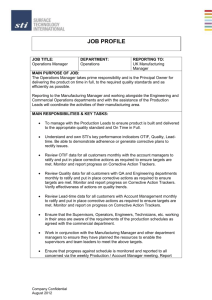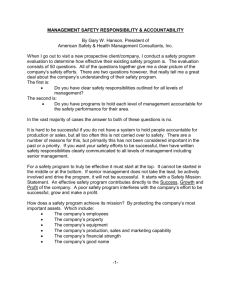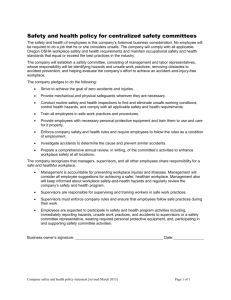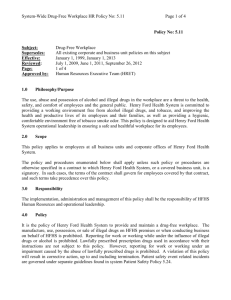SAFETY CULTURE SUMMARY – Bridging To The Future
advertisement
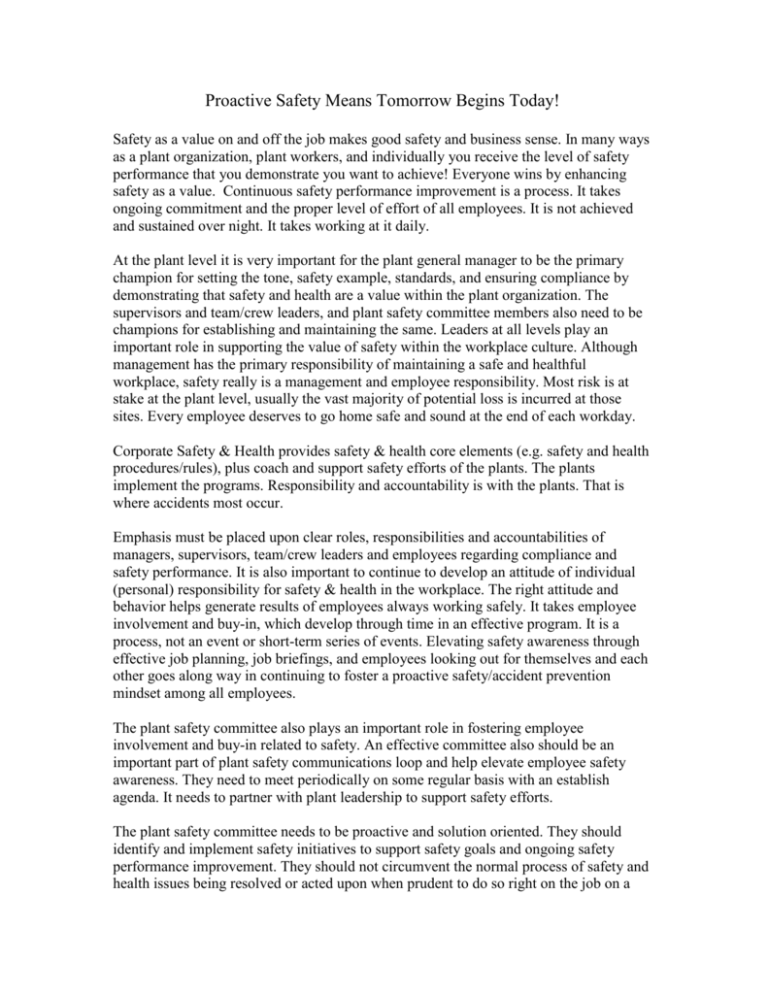
Proactive Safety Means Tomorrow Begins Today! Safety as a value on and off the job makes good safety and business sense. In many ways as a plant organization, plant workers, and individually you receive the level of safety performance that you demonstrate you want to achieve! Everyone wins by enhancing safety as a value. Continuous safety performance improvement is a process. It takes ongoing commitment and the proper level of effort of all employees. It is not achieved and sustained over night. It takes working at it daily. At the plant level it is very important for the plant general manager to be the primary champion for setting the tone, safety example, standards, and ensuring compliance by demonstrating that safety and health are a value within the plant organization. The supervisors and team/crew leaders, and plant safety committee members also need to be champions for establishing and maintaining the same. Leaders at all levels play an important role in supporting the value of safety within the workplace culture. Although management has the primary responsibility of maintaining a safe and healthful workplace, safety really is a management and employee responsibility. Most risk is at stake at the plant level, usually the vast majority of potential loss is incurred at those sites. Every employee deserves to go home safe and sound at the end of each workday. Corporate Safety & Health provides safety & health core elements (e.g. safety and health procedures/rules), plus coach and support safety efforts of the plants. The plants implement the programs. Responsibility and accountability is with the plants. That is where accidents most occur. Emphasis must be placed upon clear roles, responsibilities and accountabilities of managers, supervisors, team/crew leaders and employees regarding compliance and safety performance. It is also important to continue to develop an attitude of individual (personal) responsibility for safety & health in the workplace. The right attitude and behavior helps generate results of employees always working safely. It takes employee involvement and buy-in, which develop through time in an effective program. It is a process, not an event or short-term series of events. Elevating safety awareness through effective job planning, job briefings, and employees looking out for themselves and each other goes along way in continuing to foster a proactive safety/accident prevention mindset among all employees. The plant safety committee also plays an important role in fostering employee involvement and buy-in related to safety. An effective committee also should be an important part of plant safety communications loop and help elevate employee safety awareness. They need to meet periodically on some regular basis with an establish agenda. It needs to partner with plant leadership to support safety efforts. The plant safety committee needs to be proactive and solution oriented. They should identify and implement safety initiatives to support safety goals and ongoing safety performance improvement. They should not circumvent the normal process of safety and health issues being resolved or acted upon when prudent to do so right on the job on a real time basis. On the job efforts of employees and their leaders are critical to everyone’s safety during normal and abnormal operation of the plant. Hazard prevention and control must be a value, with items prioritized for follow up and then closure. Safety communication, safety and health procedures, safe work rules, job pre-planning, job briefings, emergency preparedness and proactive safety initiatives need to continue to be integrated in the way work gets accomplished. Supervisors and team leaders are an excellent voice for communicating safety awareness issues, recognition, and corrective action. Regulatory training (annual/periodic) helps to support compliance and employee knowledge and skills related to safe work practices. Supervisors and team/crew leaders need to continue to enforce and re-enforce those compliance requirements and safe practices on the job. Otherwise knowledge and skills learned in the training environment do not transfer into the workplace. They need to recognize good practices and correct opportunities for improvement proactively. Plant safety goals need to be established, measured and effectively communicated to employees at all levels so that they understand ongoing performance results. After all, what gets measured and communicated supports achievement. Goals need to be meaningful, measurable, and achievable with stretch built into the goals to help foster ongoing improvement. Incidents need to continue to be adequately reviewed so that lessons learned are identified, and then communicated to employees so that future similar incidents can be prevented. Incident corrective measures performed in a timely fashion will support accident prevention. Periodic assessments and inspections need to be conducted and documented to support compliance and identify good practices and the opportunities for improvement. Appropriate corrective action must be taken related to non-compliant items and opportunities for improvement. Follow through to closure is very important. Regulatory required recordkeeping must continue to be established and maintained effectively. This includes items such as but not limited to: OSHA Recordkeeping, required equipment inspections, performance measurements, corrective and preventive maintenance, and regulatory training records, etc. The safety & health program approach needs to establish a new vision and help create a bridge. This will be accomplished by developing and implementing a safety and health process, which will support facilitating the plant safety culture from the current state to the new desired culture. The cultural transition will help achieve the necessary results by supporting changing needs and continuing to improve safety performance. Every organization is uniquely designed to produce the results it achieves. Safety is a journey, not a destination. It’s continuous improvement to achieve and sustain top tier results, with employees going home safe and sound at the end of each workday.

